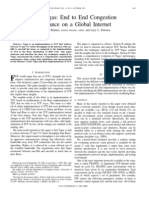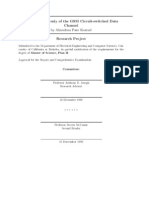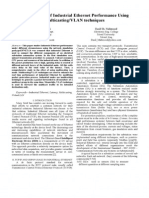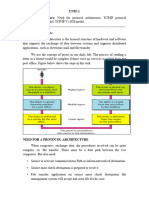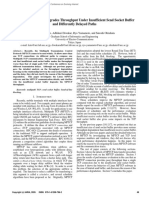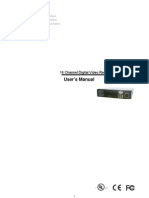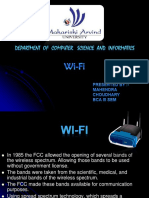Experimental Analysis of TCP and Udp Traffic Performance Over Infra-Structured 802.11B Wlans
Experimental Analysis of TCP and Udp Traffic Performance Over Infra-Structured 802.11B Wlans
Uploaded by
oldelpazo+samCopyright:
Available Formats
Experimental Analysis of TCP and Udp Traffic Performance Over Infra-Structured 802.11B Wlans
Experimental Analysis of TCP and Udp Traffic Performance Over Infra-Structured 802.11B Wlans
Uploaded by
oldelpazo+samOriginal Title
Copyright
Available Formats
Share this document
Did you find this document useful?
Is this content inappropriate?
Copyright:
Available Formats
Experimental Analysis of TCP and Udp Traffic Performance Over Infra-Structured 802.11B Wlans
Experimental Analysis of TCP and Udp Traffic Performance Over Infra-Structured 802.11B Wlans
Uploaded by
oldelpazo+samCopyright:
Available Formats
1
Experimental Analysis of TCP and UDP Trafc Performance over Infra-structured 802.11b WLANs
Andrea De Vendictis, Francesco Vacirca, Andrea Baiocchi
INFOCOM Dept. - University of Roma La Sapienza Via Eudossiana 18, 00184, Roma (Italy) Tel. +390647852306 Fax +39064744481 devendictis,vacirca,baiocchi @infocom.uniroma1.it
Abstract In this paper we present the results of experiments carried out in an infra-structured 802.11b WLAN comprising a single Access Point (AP) and a number of user terminals. The aim of this work is twofold: by the one hand, we validate well-known TCP (UDP) over 802.11 analytic models by means of experimental results; by the other hand, we focus our analysis on TCP behavior over 802.11b. We present results about ow fairness, about interaction between WLAN link layer parameters (ARQ) and transport protocols and about TCP ows trafc characteristics. With respect to earlier related works, an added value of our analysis is given by a more accurate knowledge and control of key parameters that highly affect the system performance (e.g., mobile station transmission bit-rate, maximum number of retransmission attempts, TCP version, etc.) that guarantees the reliability of numerical results. This is a key issue in order to condently explain observed experimental phenomena.
I. I NTRODUCTION In the last years, the issues regarding the behavior of TCP/IP trafc over wireless links have been extensively addressed in the networking research community, since Internet access through wireless technologies is rapidly taking up. Wireless LANs (WLANs) are among the most promising wireless technologies. In this context, collecting and analyzing experimental data is a key element for a deep understanding of TCP/IP trafc dynamics. In this paper we report the results of the analysis carried out by using experimental data collected in an infra-structured 802.11b WLAN test-bed1 . The aim is twofold: by the one hand, we validate well-known TCP and UDP over 802.11 analytic models appeared in literature. The validation against experimental results makes analytic models more reliable and possible differences between model and experimental results may help us to understand some phenomenon neglected in the model identication. Conversely, the agreement between model and experimental results makes us condent that the experimental test-bed (hardware, software, parameter conguration) works as expected, i.e. the experiment testbed is fully under control: this is a key point in order to analyze experimental data. Furthermore, a novel contribute of this work is to provide some indications about various trafc issues in 802.11b network environments: we investigated ow fairness, interaction between WLAN link layer parameters (e.g., ARQ retransmission persistence degree) and transport protocols, TCP ows trafc characteristics. Recently, several works regarding 802.11 WLANs [3] have been carried out: analytic models (e.g., [1]), simulation environments (e.g., [9] [13] ), experimental works (e.g., [13] [14] [15] [16] [17] [18] [19]) appeared in literature. As for the experimental works, in [18] and [19] the 802.11b physical channel characteristics are studied, and channel Markov models are derived. In [14] the performance of an ad-hoc 802.11b is analyzed: since the two-stations scenario studied in [14] is similar to the AP-Single Mobile Station environment also considered
This work was partially supported by the Italian FIRB Project PRIMO.
Fig. 1. Testbed layout.
in this work, some results of [14] are comparable with the ones of our work. In [17] some TCP fairness problems in an infra-structured 802.11b environment are pointed out. In [13] some performance problems, arising when stations use different transmission bit rate, are studied. In [16] an experimental study is carried out that specically points out the impact of network hardware characteristics (e.g., network interface design) on throughput performance. Also in [15] there is a study on the impact of the hardware and software design on the performance of past generation WLANs. With respect to the above cited 802.11 experimental works, in the present work we specically point out the following issues, not previously experimentally investigated: i) the impact of link layer parameters (ARQ persistence degree) on TCP/IP trafc; ii) the signicance of the so called capture effect in WLANs environments; iii) specic TCP trafc features induced by the WLAN MAC mechanisms. Main results are that capture effects may induce signicant unfairness with UDP ows, in spite of the theoretically fair 802.11 MAC protocol; on the contrary TCP congestion control is able to counter balance this effect and to yield perfect fairness. The rest of this paper is structured as follows. In Section II we describe in detail the network topology, the trafc generation software, the measurement tools and the MAC and transport protocols involved in the experiments. In Section III we discuss the main experimental results. In Section IV we give the conclusions and some hints to further work. II. T EST- BED D ESCRIPTION The testbed is depicted in Figure 1. We used two desktop PCs (one that acts as an Access Point (AP) and one that is used to monitor the on ight trafc over the wireless channel) and up to six laptop PCs (MS1 to MS6 in Figure 1, numbered according to the distance from the AP) that act as 802.11b user terminals (Mobile Stations, MSs). In the network topology, every MS is within the transmission range of all the other MS. All the MSs are placed in the same room and are non-nomadic. Although we are aware that this is just a particular network scenario (small distances among stations, indoor environment with an open space room, no specic interferences from other devices, limited number of WLAN MSs), we believe that it is a typical network environment and for this reason of great interest (e.g., ofce networks). Experiments have been carried out by varying the number of MSs between one and six, with trafc ows in uplink (the user data packets ow from the 802.11 MSs to the AP) and in downlink (the user data packets ow from the 802.11 AP to the MSs); both TCP and UDP have been used as transport protocols. The AP is the receiver host when the trafc is in uplink and is the sender host when the trafc is in downlink; therefore the trafc only crosses the WLAN air interface.
Every PC is equipped with the Linux operative system with the 2.4 or 2.6 kernel and with an 802.11b compliant PCI card driven by the Intersil Prism 2.5 chip-set [20]. The choice of this chip-set has been motivated by the high recongurability of the chip-set options and by the possibility to use the HOSTAP driver [21] to implement a home made AP system with off-the-shelf hardware. In fact, the Prism 2.5 chipset (that is used both in WLAN host cards and in commercial APs) can be used to drive an AP in two modes: Firmware-based AP mode and Host-based AP mode. In the rst mode, used in commercial APs, the chip-set utilizes a tertiary rmware for the AP functionalities such as authentication, association and forwarding of MAC frames. In the second mode, used in our testbed, the most time-critical actions are performed by the rmware (i.e. frame transmission, frame reception and beacon and probe frame handling), whereas other functionalities (such as authentication and association) are demanded to the host driver (the HOSTAP driver in our testbed). Moreover, the Prism MAC rmware implements a monitor mode that allows a Monitor Station to receive and pass to the host driver every frame with a PLCP header correctly received, irrespective of MAC frame FCS errors, along with baseband layer informations such as signal and noise levels. Tests have been done by varying the maximum number of retransmissions allowed by the 802.11 MAC layer, varying the size of data packets (fragmentation has been disabled), disabling any power control mechanisms and the RTS/CTS mechanism and forcing the terminals to use the maximum bit-rate permitted by the 802.11b standard, i.e. 11 Mbit/s 2. The key parameters (e.g., DIFS, SIFS, MAC header, etc.) of 802.11b MAC layer are set according to the standard values, listed in Table I.
TABLE I
802.11 B CONFIGURATION VALUES .
SIFS DIFS Slot Time
32 Slot Time 1024 Slot Time
MAC header bytes PHY header bytes MAC ack header bytes Bit Rate Mbit/s
The TCP into the used system kernels is the NewReno version [4][5] with the SACK option [6] and the window scaling option [8] enabled; TCP ACKs are sent according to the delayed ACK algorithm (see [7] for a detailed insight into the linux TCP congestion control implementation). As for the TCP receiver, it is congured so that it does not limit the TCP sender congestion window. The software used to produce UDP trafc is trafc generator 2.0 [23], whereas the one used to generate TCP trafc is a modied version of ttcp [22], changed to allow the ttcp server to accept multiple TCP connections simultaneously. The tool used to sniff on ight wireless frames is ethereal [24] and it is placed on the Monitor Station. Since the frames are captured on the wireless link, we are able to read all the protocol headers, from MAC to transport layer. In order to give a picture as complete as possible, the network environment where the experiments were performed, in this section we discuss two signicant elements that characterized the 802.11b physical channel: the Signal to Noise Ratio (SNR) and the MAC frame error probability. The Prism 2.5 chip-set enables us to extract the signal level and the noise level that characterize the reception of every packet3 ; these values have been successively converted in dBm. To analyze a typical
The 802.11 MAC transmission bit-rate fall back control reacts after a user-congured number of frame retransmissions at the MAC layer. Since the interface interprets the frame loss as an indication of bad channel, it reduces the transmission bit-rate if it experiences a given number of consecutive frame losses. Note that there is no distinction between frame losses due to collisions and the ones caused by the channel state. In the experiments, we turned off this policy so to have always a transmission bit-rate of 11Mb/s. A similar policy is even applied by the chipset to decide whether using the RTS/CTS mechanism or not: after a user-dened number of consecutive frame retransmissions, the interface automatically switches to the RTS/CTS access mode. We congured the chip-set so that it never enters RTS/CTS access mode. We are not pretending the one we set is the best operation mode: at this point of our study, it is essential to make us fully condent about experiments settings and henceforth result analysis and their interpretation. The noise level is dened as the last signal level before the reception of the packet.
70 65 60 55 SNR dB 50 45 40
CDF
10
10
10
10
10
35 30 0
10
5
10
15
20 Time (s)
25
30
35
40
35
40
45
50 dB
55
60
65
70
(a) SNR sample trace Fig. 2. Physical channel characterization.
(b) SNR CDF.
SNR behavior, the 802.11b MSs have been switched off and the AP set to send a beacon frame every 1 ms4 ; this mechanism has been used to control the time the packets are sent and to guarantee that samples are almost equally spaced in time and do not suffer from any collision or buffer problem: no other packets were in ight during the experiments. In order to give the reader a direct indication of the SNR dynamics, an example of the behavior of the SNR as function of the time is shown in Figure 2(a). It can be noted that the SNR varies very rapidly, even if the sender and the receiver do not move. The mean value of the depicted trace is 48.73 dB and the standard deviation is 5.88 dB; at some points the SNR falls 12/13 dB below the mean value. It has been veried that uctuations are due to signal level variations and not to background noise; the value of the noise is quite constant. Similar values have been obtained for different vendor Prism 2.5 cards and for different distances between the receiver and the transmitter 5. Figure 2(b) depicts the experimental Cumulative Distribution Function (CDF) of the SNR in dB, i.e. the probability that SNR is lower than the abscissa value. The step trend is due to the granularity of the estimates provided by the 802.11b card baseband layer. In all the analyzed experiments the average SNR is always not less than 24 dB. Highly related to the SNR values is the MAC frame loss probability ( ). Given the above values of SNR (in the order of some tens of dB), we expect that the value of is negligible. We estimated by using a simple network conguration with the AP and a single MS placed at different distances within the room. The MS sends UDP packets continuously and because it is alone the only lost MAC frames are due to channel errors. In these AP-single MS experiments, we obtained values of of the order of for the furthest MS. Therefore, in the analysis done in the next section, we can condently assume that the frame losses due to physical errors are negligible and that the frame losses are only caused by MAC collision events.
III. E XPERIMENTAL R ESULTS A rst part of experiments has been carried out by using UDP sources, each one placed on a MS and working in saturation mode, i.e. the transmitting station has always data to send. This allows us to compare the experimental results with the numerical values provided by the well-known 802.11 analytic model described in [1].
This is the minimum value of the beacon frame inter-departure time allowed by the Prism 2.5 chip-set. Obviously the mean value of the SNR decreases as the distance increases.
x 10 6 5.5 5 4.5 4 3.5 3 2.5
7
Experiments Model
x 10
6.5
IP throughput (bit/s)
IP throughput (bit/s)
6 5.5 5 4.5 4 3.5 Experiments Model 2 3 4 5 6
300 400
600
800
1000
1200
1500
3 1
IP packet size (byte)
(a) Single UDP source in saturation. Fig. 3. UDP - Comparing model and experimental results.
Number of mobile stations
(b) Multiple UDP sources in saturation.
In Figure 3(a) the performance of a single UDP source (in terms of IP throughput) is analyzed as function of the IP packet size. In the paper, the term IP throughput (IP packet size) means the throughput (size) computed by including data, transport protocol (UDP or TCP) header, IP header, whereas LLC, PLCP and MAC headers are considered overhead. Model and experimental values are very close to each other and show that 802.11b performance increases by increasing the packet size. Whereas experiments validate the accuracy of the analytic model, conversely the agreement between model and experimental values represents an indirect way to verify that the all the components (hardware, software, parameters) of the testbed are working as expected6 . In Figure 3(b) we show UDP performance (in terms of cumulative throughput of the saturated sources) as a function of the number of MSs. Also in this case the trafc is in uplink but the IP packet size is xed to 1500 bytes. There is almost exact agreement between simulation and analytic results: rst, when there is a small number of active MSs, the cumulative throughput increases since the overhead of the 802.11b contention window algorithm reduces with the number of competing MSs; there is a maximum cumulative throughput when the number of UDP sources is three, then the throughput decreases as the number of MSs increases because of the presence of collision events. In Figure 4(a) we evaluate 802.11b UDP sources fairness. Although 802.11b MAC protocol is known as a fair protocol (at least for long-term behavior), we found out a non negligible unfairness phenomenon, that favors the mobile stations closer to the AP. The gure shows the throughput (in terms of pkts/s) of six UDP sources in saturation (IP packet size is 1500 byte). Note that we veried that the bit-rate of all the sources is always 11 Mb/s during the experiments (we turned off the interface function that is able to change the transmission bit-rate, as pointed out in footnote 2). The unfairness phenomenon is caused by the well-known capture effect: given two signals, the receiver treats the stronger one as signal and the weaker one as noise. To this effect the receiver station is able to decode the stronger signal (belonging to the closer station) but not the weaker one; therefore, the closer station performs a successful transmission, whereas the further MS detects a collision. This phenomenon is conrmed by computing the retransmission probability7 for each MS so as observed by the Monitor Station (see Table II): the further the MS, the higher
In a number of earlier related works appeared in the literature, there is no agreement between experimental results and model predictions, and the source of such differences is not clearly explained. For retransmission probability, we intend the probability that a MAC frame is retransmitted at least once by a MS. Note that, the retransmission probability is different from the collision probability, i.e. the probability that a frame is involved in a collision: in fact, the Monitor Station can only detect the successfully transmitted frames, whereas collisions cannot be detected; we can distinguish a frame transmitted only once from a retransmitted one thanks to the Retry eld within the 802.11b MAC header.
Fairness index
0.98
0.96
MR=0 MR=8 MR=50
0.94 3
Number of mobile stations
(a) Multiple UDP sources in saturation - Fairness. (b) Fairness - Varying the maximum number of retransmission attempts.
Fig. 4. UDP fairness
the probability of retransmission due to collision events 8. Although the capture effect does not impair the global efciency of 802.11b (instead, better performance is reached since a smaller number of collision events are actually detected), the single station can achieve a throughput quite different from its fair share.
TABLE II
R ETRANSMISSION PROBABILITY FOR EACH MS.
MS1 MS2 MS3 MS4 MS5 MS6 0.110 0.151 0.263 0.272 0.286 0.305 In Figure 4(b) we show the fairness degree as function of the number of MSs and of the maximum number of retransmission attempts allowed by the 802.11b MAC layer. The fairness degree has been computed applying the widely used fairness index dened in [2]:
where is the throughput of the -th MS and is the total number of active MSs. According to the Figure 4(b), the fairness decreases as the number of MSs increases (since the capture effect increases) and as the number of maximum retransmission attempts increases (since the 802.11b MAC exponential backoff degrades the performance of those stations that detect collisions, and the exponential backoff is the larger as the maximum number of retransmissions increases). Once validated the experimental testbed by using UDP sources in saturation, we evaluate TCP performance over 802.11b wireless LAN. As already pointed out in Section II the end hosts of all the TCP connections are the 802.11b MS and the AP; therefore, as for the base round trip time of each TCP connection, it is of the order of few milliseconds, i.e. the time required to TCP data and ACKs to cross the wireless channel. Figure 5 depicts the TCP performance when the TCP trafc is in uplink. First of all, the throughput obtained by a single TCP source experiment is validated against the values obtained by the ideal TCP over
As already pointed out in Section II, the packet loss due to channel errors is assumed a negligible event.
5.5 5
x 10
5.4
Experiments Model
x 10
5.2
IP throughput (bit/s)
4.5 4 3.5 3 2.5 2 1.5 200
IP throughput (bit/s)
5 4.8 4.6 4.4 4.2 4 3.8 M =0 R MR=1 MR=2 MR=8 MR=16 MR=50
400
600
800
1000
1200
1400
1600
3.6 1
IP packet size (byte)
(a) Single TCP source in saturation - Comparing model and experimental results. Fig. 5. TCP performance - uplink.
Number of mobile stations
(b) TCP performance - uplink - Varying the maximum number of retransmission attempts.
802.11 model proposed in [14], for different values of IP packet size. In Figure 5(a) the experimental and . This value of guarantees model results are shown for different TCP packet sizes by setting that there are no TCP packet losses due to MAC collisions between TCP data and ACKs. In case of , TCP performance decreases because packet losses are not completely hidden to TCP by the MAC layer and in this case the value predicted by the analytic model appears to be inaccurate. In Figure 5(b) we show the TCP performance as function of the number of MSs and for different values of the maximum number of retransmission attempts (the IP packet size is 1500 bytes). (where the single TCP connection cannot saturate the available capacity because Except for of packet losses), the global efciency slightly decreases with the number of MSs: this is caused by the increasing of the collision events. turns out to yield bad performance, when the As for the impact of values, whereas using MSs are more than three the optimal value of changes with the number of MSs, even if the performance are very close. For example, with six MSs, setting to 50 can be worst than using a smaller maximum number of MAC retransmissions.
TABLE III
S OURCE R ETRANSMISSION PROBABILITY.
# MSs 1 2 3 4 5 6 TCP - Uplink 0.05 0.098 0.084 0.08 0.081 0.067 TCP - Downlink 0.099 0.108 0.124 0.133 0.130 0.131 UDP 0.048 0.109 0.159 0.163 0.183 In Figure 6 we show the performance of TCP when all the connections are downlink, i.e. only the AP sends data packet and MSs only send TCP ACKs. Figure 6(a) depicts the TCP/IP throughput varying the number of active MSs for different values of . When is 0, the performance are very low because of high packet loss rate. When , the TCP performance seems to be rather constant with the number of active MSs. In Figure 6(b), the TCP performance varying the maximum number of retransmission attempts for dif to reach the maximum ferent values of the active MSs. It is to notice that it is sufcient to have performance. This indicates that, when the TCP trafc is in downlink, to have more than one consecutive
5.4 5.2
x 10
5.4 5.2 5
x 10
IP throughput (bit/s)
IP throughput (bit/s)
5 4.8 4.6 4.4 4.2 4 3.8 3.6 3.4 1 2 3 4 5 6 MR=0 MR=1 MR=4 MR=50
4.8 4.6 4.4 4.2 4 3.8 3.6 3.4 0 5 10 15 20 25 30 35 N=1 N=3 N=4 N=5 N=6
40
45
50
Number of mobile stations
(a) Varying the maximum number of retransmission attempts. Fig. 6. TCP performance - downlink.
Maximum number of MAC transmission attempts
(b) Varying the number of mobile stations.
(a) uplink. Fig. 7. TCP fairness
(b) downlink.
collision is highly unlikely. In table III we show the average frame retransmission probabilities 9 in case of TCP (uplink and downlink trafc) and UDP when the number of competing MSs varies from 1 to 610 . With TCP, the MSs detect less collisions than in presence of UDP; TCP is able to strongly reduce the number of collisions when the trafc is uplink. The reason of this behavior will be explained in the following. In Figure 7 we evaluate the fairness degree of the TCP ows. It is to note that in both the cases (uplink trafc in Figure 7(a) and downlink trafc in Figure 7(b)) the fairness degree is much larger than the one obtained with UDP trafc; this indicates that TCP is able by itself to overcome the capture effect of the WLAN. Furthermore, the trafc in uplink appears to be fairer than downlink one. In Figure 8 we show by means of texture diagrams11 the TCP packet arrivals in the wireless channel
As
The average retransmission probability is computed by averaging the retransmission probabilities of each active MS. for UDP, in case of a single MS there are no collisions. The texture diagram is obtained by randomly splitting the points over a vertical interval so to have a clearer vision of the density of the
(a) uplink. Fig. 8. TCP Trafc - Data and ack packet arrivals - Six connections.
(b) downlink.
(a) uplink. Fig. 9. TCP Trafc - Number of competing ows - Six connections.
(b) downlink.
respectively for uplink connections (Figure 8(a)) and for downlink connections (Figure 8(b) in case of six TCP ows. For each ow, we show both TCP data packets (black points) and TCP ACKs (gray points). You can note that when there are only TCP uplink connections (Figure 8(a)), trafc appears in well dened bursts; moreover, in every time instant only few MSs are actually active. As for the downlink connections (Figure 8(b)), the packets belonging to different ows are more uniformly distributed along the time. This behavior is conrmed by Figure 9, where it is shown the number of competing TCP connections in non-overlapping time slots of duration 20 ms, i.e. a station is assumed competing for the medium access if at least a packet belonging to it appears on the wireless channel in a time slot. This duration is considered enough to estimate the number of stations that are actually asking for the channel (a single packet of 1500 bytes is transmitted in about 1 ms, if no collision occurs). In Figure 9(a) we show uplink TCP connections: for most of the time, there are two or three stations (including the AP) competing for the medium access in every slot; there are never more than four ows. In Figure 9(b) we show the case of downlink connections:
observed events over time.
10
in each time slot there are typically more active TCP ows than in uplink case, even seven. By directly analyzing the collected trafc traces, we pointed out that, when the trafc is in uplink and TCP in steady-state, the TCP ACKs belonging to the same TCP connection are sent in group by the AP. At this point of our study, we can suppose that this behavior is favored by a number of causes during the transient: i) the fact that TCP connections begin in different instants, so one connection can send several packets consecutively; ii) the presence of the initial slow start, according to which TCP packets are sent in bursts by the source; iii) the presence of the capture effect, that can favors at some time the MSs closer to the AP, so that it can send more packets consecutively. However, once that a MS, say the MS , has sent a number of consecutive data packets, the AP cannot send the corresponding ACKs with the same rate indenitely: in fact, the AP has the same probability as is the number of active MSs. each MS of accessing the channel, i.e. in the worst case if Therefore, at some time, the MS has to stop sending data packets because the lack of TCP ACKs does not allow it to update the congestion window. At that time, the other MSs, if allowed by their congestion window, can send their packets, without competing for the channel access with the MS . The fact that some MSs stops transmitting favors even more the formation of packet bursts. The MS will be able to send again data packets only after receiving the next ACK, that will be sent by the AP when the ACK will reach the head of its buffer. This is the reason why only few MSs are effectively active in every instant. This behavior also explains other two facts that have been shown when the TCP connections are in uplink: i) the high fairness among TCP ows (Figure 7(a)): since each ow does not have to compete with all the others (only few MSs are actually competing in every instant for the channel), the impact of the capture effect is strongly relaxed (in steady-state; instead, as explained above, the capture effect may contribute to group the TCP ACKs in the transient); ii) the small retransmission probability (see Table III). When the TCP trafc is in downlink the MSs send TCP ACKs and the AP sends TCP data packets. In the worst case, i.e. when all the stations want to access the channel, the AP has a probability of accessing the channel equal to if is the number of MSs. Hence the AP is the bottleneck and each MS is able to send the TCP ACKs with the same rate of the TCP data packets. Therefore, in this case, the TCP source congestion windows are not limited by the lack of ACKs and each TCP source can always send new data. This fact and the fact that the arrival of ACKs at the AP is randomized by the 802.11b MAC guarantee that the trafc is not in bursts. In the present work, we found that the capture effect has a strong impact on UDP performance and even some non negligible impact on downlink TCP trafc fairness degree. Although we turned off the 802.11 MAC transmission rate fall-back control of all the stations (see footnote 2), the performance of each mobile station depends on its position. What does it happen if we turn on the 802.11 MAC transmission rate fall-back control, so to allow each station to adapt its transmission transmission rate to the perceived channel status? In this case, since the far MSs will experience more collisions than the MSs closer to the AP, these MSs will experience with higher probability the transmission rate fall-back control, even if the actual channel state is good. These MSs will obtain worst performance. Furthermore, considering the anomalies pointed out in [13], the bad performance of far MSs will affect all the other MSs of the WLAN, with a global WLAN throughput performance deterioration. Therefore, a study of the negative interaction among collision events, transmission rate control and capture effect should be a key issue for the development of the WLAN technology.
IV. C ONCLUSIONS In this paper we present an accurate analysis of experimental TCP/IP trafc data collected in a 802.11b WLAN testbed. A validation of well-known TCP/UDP analytic models has been performed and some key properties of TCP/IP trafc in an infrastructured 802.11 WLAN has been pointed out (e.g., impact of the capture effect in UDP and TCP trafc performance, TCP trafc patterns, different performance for downlink and uplink TCP connections).
11
As further work, in addition to the one discussed in the earlier section, we want to extend the experimental analysis to different network scenarios (e.g., a larger number of MSs, different offered trafc patterns (e.g. short TCP connections), TCP connections with higher round trip times, mixed uplink/downlink TCP trafc). R EFERENCES
[1] G. Bianchi, Performance Analysis of the IEEE 802.11 Distributed Function, IEEE Journal of Selected Areas in Telecommunications, Vol. 18, No. 3, pp. 535-547, March 2000. [2] Raj Jain, Arjan Durresi, Gojko Babic, Throughput Fairness Index: An Explanation, ATM Forum/99-0045, February 1999, available at http://www.cis.ohio-state.edu/jain/atmf/a99-0045.htm [3] ANSI/IEEE, 802.11: Wireless LAN Medium Access Control (MAC) and Physical Layer (PHY), Specications 2000. [4] R. W. Stevens, TCP/IP Illustrated,Vol I The protocols, Addison-Wesley, U.S.A., 1994. [5] S. Floyd, T. Henderson, The NewReno Modication to TCPs Fast Recovery Algorithm, RFC2582, IETF, April 1999. [6] J. Mahdavi et al., TCP Selective Acknowledgment Options, RFC2018, IETF, October 1996. [7] P. Sarolahti, A. Kuznetsov, Congestion Control in Linux TCP, [8] V. Jacobson, R. Braden, TCP Extensions for Long-Delay Paths, RFC1072, IETF, October 1988. [9] M. Methfessel et al., Vertical Optimization of Data Transmission for Mobile Wireless Terminals, IEEE Wireless Communications Magazine, December 2002. [10] M. Bottigliengo, C. Casetti, C. F. Chiasserini, M. Meo, Short-term Fairness for TCP Flows in 802.11b WLANs, Proc. of IEEE Infocom 2004. [11] R. Bruno, M. Conti, E. Gregori, Analytical Modeling of TCP Clients in Wi-Fi Hot Spot Networks, Proc. Networking 2004. [12] H. Balakrishnan, V. N. Padmanabhan, How Network Asymmetry Affects TCP, IEEE Communications Magazine, April 2001. [13] M. Heusse, F. Rousseau, G. Berger-Sabbatel, A. Duda, Performance Anomaly of 802.11b, Proc. of IEEE INFOCOM, 2003. [14] G.Anastasi, E. Borgia, M. Conti, E. Gregori, IEEE 802.11 Ad Hoc Networks: Performance Measurements, 23rd International Conference on Distributed Computing Systems Workshops (ICDCSW03), May 19 - 22, 2003, Providence, Rhode Island, USA. [15] G. Xylomenos, G. C. Polyzos, TCP and UDP Performance over a Wireless LAN, Proc. of IEEE INFOCOM, 1999. [16] A. Vasan and A. U. Shankar, An Empirical Characterization of Instantaneous Throughput in 802.11b WLANs, technical report, available at http://www.cs.umd.edu/ shankar/selected-publications.html [17] S. Pilosof, R. Ramjee, D. Raz, Y. Shavitt, and P. Sinha, Understanding TCP Fairness over Wireless LAN, Proc. of IEEE INFOCOM 2003, San Francisco, CA, USA, Mar. 2003. [18] J. Aruz, P. Krishnamurthy, Markov Modeling of 802.11 channels, Vehicular Technology Conference, 2003. VTC 2003-Fall. 2003 IEEE 58th , Volume: 2 , 6-9 Oct. 2003. [19] S. Karande, S. A. Khayam, M. Krappel and H. Radha, Analysis and Modeling of Errors at the 802.11b Link Layer, Multimedia and Expo, 2003. ICME 03. Proceedings. 2003 International Conference on , Volume: 1 , 6-9 July 2003. [20] RM025, Prism Driver Programmers Manual, June 2002, Intersil. [21] hostap, software available at http://hostap.epitest.. [22] ttcp, software available at http://ftp.arl.mil/ mike/ttcp.html. [23] tg, software available at http://www.postel.org/tg/tg.htm. [24] ethereal 0.10.4 release, available at http://www.ethereal.com.
You might also like
- ICT - Question Bank (Basic Computer)Document3 pagesICT - Question Bank (Basic Computer)Shafeek Ghreeb88% (25)
- From GSM to LTE-Advanced Pro and 5G: An Introduction to Mobile Networks and Mobile BroadbandFrom EverandFrom GSM to LTE-Advanced Pro and 5G: An Introduction to Mobile Networks and Mobile BroadbandNo ratings yet
- Ieee Performance Evaluation: Convergence of Theoreti Cal, Simulation and Experimental ResultsDocument6 pagesIeee Performance Evaluation: Convergence of Theoreti Cal, Simulation and Experimental ResultsGuillermo Rgz BNo ratings yet
- Performance Evaluation of TCP Reno, SACK and FACK Over WimaxDocument5 pagesPerformance Evaluation of TCP Reno, SACK and FACK Over WimaxHarjinder191No ratings yet
- TCP-UB: A New Congestion Aware Transmission Control Protocol VariantDocument13 pagesTCP-UB: A New Congestion Aware Transmission Control Protocol VariantAIRCC - IJCNCNo ratings yet
- TCP Vegas: End To End Congestion Avoidance On A Global InternetDocument16 pagesTCP Vegas: End To End Congestion Avoidance On A Global InternetUmi UmiNo ratings yet
- Report Final PDFDocument49 pagesReport Final PDFSlaven IvicNo ratings yet
- Performance Study of The GSM Circuit-Switched Data Channel Research ProjectDocument25 pagesPerformance Study of The GSM Circuit-Switched Data Channel Research ProjectnngoweNo ratings yet
- MPEG-4 Performance Analysis For A CDMA Network-on-Chip: Manho Kim, Daewook Kim and Gerald E. SobelmanDocument4 pagesMPEG-4 Performance Analysis For A CDMA Network-on-Chip: Manho Kim, Daewook Kim and Gerald E. SobelmanraghavaNo ratings yet
- TCP Analysis Over Wireless Mobile Ad Networks: Ankur Ankur Pruthi, R. C. PDocument5 pagesTCP Analysis Over Wireless Mobile Ad Networks: Ankur Ankur Pruthi, R. C. Pmanik_mittal3No ratings yet
- CH4 5Document8 pagesCH4 5mohammed A ALJalilNo ratings yet
- Buffer Sizing For 802Document12 pagesBuffer Sizing For 802RamJiNo ratings yet
- Enhancement of Industrial Ethernet Performance Using Multicasting/VLAN TechniquesDocument6 pagesEnhancement of Industrial Ethernet Performance Using Multicasting/VLAN Techniquesraghavendran raghuNo ratings yet
- Buffer Sizing For 802.11 Based Networks: AbstractDocument11 pagesBuffer Sizing For 802.11 Based Networks: AbstractHitesh AddankiNo ratings yet
- A Simulation-Based Study of TCP Dynamics Over HFC Networks: Omar Elloumi, Nada Golmie, Hossam A®®, David SuDocument17 pagesA Simulation-Based Study of TCP Dynamics Over HFC Networks: Omar Elloumi, Nada Golmie, Hossam A®®, David SumkjdlNo ratings yet
- TCP and UDP Performance Comparison in Network On ChipDocument5 pagesTCP and UDP Performance Comparison in Network On ChipJournal of ComputingNo ratings yet
- Measurements in A Laboratory UMTS Network With Time-Varying Loads and Different Admission Control StrategiesDocument10 pagesMeasurements in A Laboratory UMTS Network With Time-Varying Loads and Different Admission Control StrategiesEmad NiriNo ratings yet
- SCTP vs. TCP - Comparing Packets Loss Rate of Transport Protocols in Best-Effort NetworksDocument8 pagesSCTP vs. TCP - Comparing Packets Loss Rate of Transport Protocols in Best-Effort NetworksMahmoud DoughanNo ratings yet
- DCF Learn and Performance Analysis of 802.11B Wireless NetworkDocument13 pagesDCF Learn and Performance Analysis of 802.11B Wireless NetworkAIRCC - IJCNCNo ratings yet
- Multi-User Downlink With Single-User Uplink Can Starve TCPDocument9 pagesMulti-User Downlink With Single-User Uplink Can Starve TCPPeshal NayakNo ratings yet
- VSATDocument11 pagesVSATShashwat TiwariNo ratings yet
- Wireless Communications - 2004 - Anantharaman - TCP Performance Over Mobile Ad Hoc Networks A Quantitative StudyDocument20 pagesWireless Communications - 2004 - Anantharaman - TCP Performance Over Mobile Ad Hoc Networks A Quantitative Studyafe123.comNo ratings yet
- 802.11 AMPDU and AMSDU Performance 2007Document5 pages802.11 AMPDU and AMSDU Performance 2007Fabian TrumperNo ratings yet
- Performance of TCP Over UMTS Common and Dedicated Channels: A. System ArchitectureDocument5 pagesPerformance of TCP Over UMTS Common and Dedicated Channels: A. System Architecturerfbrunei50% (2)
- TCP IP ApplicationsDocument10 pagesTCP IP ApplicationsJetesh DevgunNo ratings yet
- Steganography in Long Term Evolution Systems: Iwona Grabska, Krzysztof SzczypiorskiDocument8 pagesSteganography in Long Term Evolution Systems: Iwona Grabska, Krzysztof SzczypiorskiAjay Kumar SwarnkarNo ratings yet
- Chapter Eight Network Control and Monitoring: Circuit SwitchingDocument7 pagesChapter Eight Network Control and Monitoring: Circuit Switchingshavali56No ratings yet
- Performance Enhancement of Wi-Fi Ad-Hoc Network For Voip SupportDocument11 pagesPerformance Enhancement of Wi-Fi Ad-Hoc Network For Voip SupportKaran ReddyNo ratings yet
- Lecture Notes 1 Networking Basics Fall22Document12 pagesLecture Notes 1 Networking Basics Fall22woyecex875No ratings yet
- Opnet ResearchDocument7 pagesOpnet Researchhossam80No ratings yet
- Fast ARQ in High Speed Downlink Packet Access For WCDMA SystemsDocument7 pagesFast ARQ in High Speed Downlink Packet Access For WCDMA SystemsTorsion TesnorNo ratings yet
- Assignment - 3Document8 pagesAssignment - 3Shivam SharmaNo ratings yet
- A Capacity Analysis For The IEEE 802.11 MAC Protocol: P S P P S W N G W N W N P S W S SDocument22 pagesA Capacity Analysis For The IEEE 802.11 MAC Protocol: P S P P S W N G W N W N P S W S SShashank BhadaniNo ratings yet
- Network Layer Samia'Document10 pagesNetwork Layer Samia'Dark GardianNo ratings yet
- Singh JatinderTOWCDocument16 pagesSingh JatinderTOWCAnonymous BkmsKXzwyKNo ratings yet
- Delay Analysis 80211Document14 pagesDelay Analysis 80211123asd456fNo ratings yet
- Communication Load of TCP With Delayed ACK and UDP in Network On ChipDocument5 pagesCommunication Load of TCP With Delayed ACK and UDP in Network On ChipJournal of ComputingNo ratings yet
- Modeling and Performance Evaluation of LTE Networks With Different TCP VariantsDocument6 pagesModeling and Performance Evaluation of LTE Networks With Different TCP Variantsps0601No ratings yet
- LTE Protocol Stack LayersDocument7 pagesLTE Protocol Stack Layersmd1234_1984No ratings yet
- DC Module1 2Document13 pagesDC Module1 2pbayanagNo ratings yet
- Ieee 802.11 Optimal Performances: Rts/Cts Mechanism vs. Basic AccessDocument5 pagesIeee 802.11 Optimal Performances: Rts/Cts Mechanism vs. Basic AccessqhidNo ratings yet
- Osi Layer and Communication Between Two Node in A NetworkDocument11 pagesOsi Layer and Communication Between Two Node in A NetworkAbhishek BohraNo ratings yet
- Turning Hidden Nodes Into Helper Nodes in IEEE 802.11 Wireless LAN NetworksDocument12 pagesTurning Hidden Nodes Into Helper Nodes in IEEE 802.11 Wireless LAN NetworksphdmadhuNo ratings yet
- HTTP Problem LTEDocument12 pagesHTTP Problem LTEErsin ADALNo ratings yet
- Why Multipath TCP Degrades Throughput UnDocument6 pagesWhy Multipath TCP Degrades Throughput UnMohamed NaimiNo ratings yet
- Hybrid Pon Omnetpp2011Document8 pagesHybrid Pon Omnetpp2011blizanac87No ratings yet
- Performance Impairments in Single-Mode Radio-Over-Fiber Systems Due To MAC ConstraintsDocument9 pagesPerformance Impairments in Single-Mode Radio-Over-Fiber Systems Due To MAC ConstraintsDiptanil DebBarmanNo ratings yet
- Effects of TCP Window Size and Transmission Range On The Throughput of Mobile Adhoc Data NetworkDocument8 pagesEffects of TCP Window Size and Transmission Range On The Throughput of Mobile Adhoc Data NetworksamplusNo ratings yet
- 802.15.4 Simulation in Omnet++Document4 pages802.15.4 Simulation in Omnet++Ahmed HanyNo ratings yet
- TCP Congestion Control Through Bandwidth Estimation Mechanism in MANETDocument8 pagesTCP Congestion Control Through Bandwidth Estimation Mechanism in MANETBadshaa DonNo ratings yet
- Fig.1.14 Logical Connections Between Layers of The TCP/IP Protocol SuiteDocument34 pagesFig.1.14 Logical Connections Between Layers of The TCP/IP Protocol SuiteNadeem PashaNo ratings yet
- Computer Network Long Questions & AnswerDocument12 pagesComputer Network Long Questions & Answersravan123No ratings yet
- Evaluation of Different TCP Congestion Control Algorithms Using NS-2Document21 pagesEvaluation of Different TCP Congestion Control Algorithms Using NS-2anthony81212No ratings yet
- TCP S: A Tcp/Ip F M R H: Plitter LOW Onitor in Econfigurable ArdwareDocument6 pagesTCP S: A Tcp/Ip F M R H: Plitter LOW Onitor in Econfigurable ArdwareprarabdhavipsNo ratings yet
- TCP in Conflict-Based Wireless LinksDocument15 pagesTCP in Conflict-Based Wireless LinksResearch Cell: An International Journal of Engineering SciencesNo ratings yet
- GPRS Traffic Performance MeasurementsDocument5 pagesGPRS Traffic Performance MeasurementsAnkit BarveNo ratings yet
- P A I A P C Mac P (Iapcmp) Manet: Erformance Nalysis of Mproved Utonomous Ower Ontrol Rotocol FOR SDocument11 pagesP A I A P C Mac P (Iapcmp) Manet: Erformance Nalysis of Mproved Utonomous Ower Ontrol Rotocol FOR SijansjournalNo ratings yet
- Introduction to Internet & Web Technology: Internet & Web TechnologyFrom EverandIntroduction to Internet & Web Technology: Internet & Web TechnologyNo ratings yet
- Computer Networking: An introductory guide for complete beginners: Computer Networking, #1From EverandComputer Networking: An introductory guide for complete beginners: Computer Networking, #1Rating: 4.5 out of 5 stars4.5/5 (2)
- BoQ Sound SystemDocument4 pagesBoQ Sound Systemjayathri pasan0% (1)
- TV HistoryDocument30 pagesTV HistoryAby AugustineNo ratings yet
- Basics of Computers - Input - Output Ports - TutorialspointDocument3 pagesBasics of Computers - Input - Output Ports - TutorialspointHassan MohamedNo ratings yet
- CCNA Discovery-Networking For Home and Small Businesses-IRGDocument13 pagesCCNA Discovery-Networking For Home and Small Businesses-IRGJunior SifronioNo ratings yet
- AV Control Receiver SA-XR59: Operating InstructionsDocument40 pagesAV Control Receiver SA-XR59: Operating InstructionsDenica IvanovaNo ratings yet
- Total Amount Due: P1,799.00: BIR CAS Permit No. 0415-126-00187 SOA Number: I000051735833Document2 pagesTotal Amount Due: P1,799.00: BIR CAS Permit No. 0415-126-00187 SOA Number: I000051735833Pia Ber-Ber BernardoNo ratings yet
- Photo Story Book Margin Guidelines: MINI (3x3)Document21 pagesPhoto Story Book Margin Guidelines: MINI (3x3)Mosi Leigh CataloNo ratings yet
- Log 2016-12-14 12-03-12Document139 pagesLog 2016-12-14 12-03-12redsaqNo ratings yet
- FST Dfs Dnp3 EthernetDocument4 pagesFST Dfs Dnp3 EthernetEric DunnNo ratings yet
- Orbix 16 Users Manual (Older)Document51 pagesOrbix 16 Users Manual (Older)ingherreramNo ratings yet
- Manual Philips LED TV 40HFL5010T/12Document63 pagesManual Philips LED TV 40HFL5010T/12Stef van OverdijkNo ratings yet
- Color Lookup Adjustments: by Martin EveningDocument6 pagesColor Lookup Adjustments: by Martin EveningZsuzsaNo ratings yet
- IBasso DX80 ManualDocument32 pagesIBasso DX80 ManualMedevilxNo ratings yet
- Ofdm Physical Layer Simulation of Ieee 802.16-2009 (Mobile Wimax)Document30 pagesOfdm Physical Layer Simulation of Ieee 802.16-2009 (Mobile Wimax)SanjayKumarChaudharyNo ratings yet
- Cisco IP Conference Phone 7832 Data SheetDocument6 pagesCisco IP Conference Phone 7832 Data SheetDmitryNo ratings yet
- Sanyo DP32242 (SM)Document56 pagesSanyo DP32242 (SM)panchiscoNo ratings yet
- Chapter 2 - Output DevicesDocument32 pagesChapter 2 - Output DevicesNavin ChandrasekaranNo ratings yet
- SMP 300 enDocument2 pagesSMP 300 enZainal AbidinNo ratings yet
- Multimedia NotesDocument17 pagesMultimedia Notesashwanimpec20No ratings yet
- Data Communications Network (DCN) Planning GuideDocument47 pagesData Communications Network (DCN) Planning GuideLarba Sawadogo100% (1)
- CodecsDocument15 pagesCodecsLuís Fernando de MeloNo ratings yet
- Wireless Assignment FinalDocument16 pagesWireless Assignment FinalRamsha JahangirNo ratings yet
- Chimei N173O6 L02Document29 pagesChimei N173O6 L02alelujaNo ratings yet
- Ol EDDocument20 pagesOl EDUdbhav Maheshwari0% (1)
- QuestionnaireDocument5 pagesQuestionnaireshahhd100% (3)
- Mobile ComputingDocument5 pagesMobile ComputingNitheesh RaviNo ratings yet
- WifiDocument13 pagesWifimahendra choudharyNo ratings yet
- Pin Assignment LVDS EngDocument56 pagesPin Assignment LVDS Eng301992100% (1)
- Microsoft Picture It! Express User's Manual Microsoft Picture It! Express User's ManualDocument3 pagesMicrosoft Picture It! Express User's Manual Microsoft Picture It! Express User's Manualjeppoo1No ratings yet





